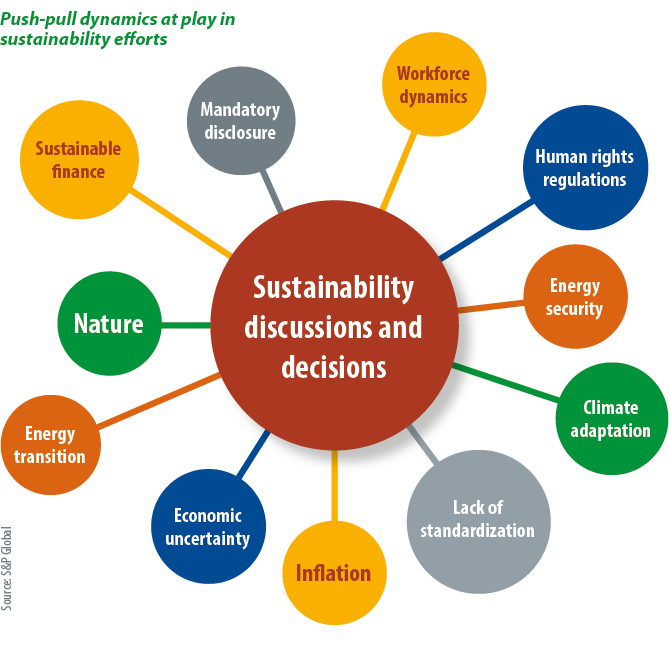Competing factors are at play in ESG reporting in 2023. While those three letters might appear to sit comfortably within the wider idea represented by the now-ubiquitous term “sustainability,” there may be dissonance. The urgent imperative to scale climate change solutions may result in corners being cut in employee relations, for instance. Equally, the need to move quickly and bring innovations to market may cause governance transparency shortfalls.
Analysts from financial information business S&P Global note “push-and-pull” dynamics will likely be a feature of sustainability “discussions and decisions” this year. Macroeconomic and political trends, the analysts note, will likely create “new tensions” as companies endeavor to meet ESG goals. These wider trends, S&P Global writes, are “geopolitical turmoil, persistent inflation, looming recession, and [the] worsening physical impacts of climate change.”
The regulatory landscape surrounding ESG disclosure is also in flux as policymakers in major jurisdictions attempt to set benchmarks and standards in a field that has emerged – and grown in importance – at quite a rate. New institutions are being formed to carry out this work.
The International Sustainability Standards Board was created last year through cooperation between European Commission advisory body the European Financial Reporting Advisory Group and federal body the US Securities and Exchange Commission. The new entity will first tackle the drafting of standards for “sustainability and/or climate-related issues.” That it is tackling environmental reporting standards first is illustrative of an ESG-reporting trend – first comes the “E,” then the “S” and “G.”
Cleantech implications
For solar and energy storage companies – which are increasingly producing sustainability or broader ESG reports as a matter of business – clearing the environmental hurdle appears to be the easiest task. That’s not to say doing so is a given, however.
 “If you look solely at products in their use, renewable energy – including solar – is a tremendous plus over traditional fossil fuels,” says Carl Smith, executive adviser to the Global Electronics Council, an Oregon-based sustainability nonprofit. “You have to also look at how the products are manufactured – how are the materials mined? How are they assembled and designed? – and to ensure that all of the design and manufacturing features don’t mitigate or offset the use of renewable energy.”
“If you look solely at products in their use, renewable energy – including solar – is a tremendous plus over traditional fossil fuels,” says Carl Smith, executive adviser to the Global Electronics Council, an Oregon-based sustainability nonprofit. “You have to also look at how the products are manufactured – how are the materials mined? How are they assembled and designed? – and to ensure that all of the design and manufacturing features don’t mitigate or offset the use of renewable energy.”
In this context, a host of environmental concerns related to solar and energy storage manufacturing leap to mind. These can include the use of toxic materials such as lead and cadmium in certain solar modules, mining practices for materials such as cobalt for some lithium-ion battery chemistries, and the use of scarce or potentially scarce materials such as silver, indium, and selenium. Water management and waste management in production also have roles to play in good ESG practice.
Embedded emissions can’t be forgotten either. For renewable energy project developers, this is often the first ESG-related question investors ask. While the energy payback from a PV project – similarly to an individual solar module – is only one year to two years, project developers are increasingly required to conduct more accurate emissions data collection and reporting.
“Solar is still incredibly popular and we need to keep it that way,” said Susannah Wood, VP of public affairs for wind and solar at Norwegian utility Statkraft, while launching the company’s “Solar: A Force for Good – ESG expectations for the solar sector” report in 2021.
There are a range of other environmental concerns to be addressed during solar project development, including impact on native wildlife, biodiversity potential, and environmental impact during construction – all of which have delayed, stalled, or otherwise created problems for project developers in the past.
Broader scope
With broader definitions encompassing the social and governance parts of ESG, the solar and energy storage industry may encounter tougher challenges. Swiss ESG investing advisory GGX has noted allegations of forced labor within some parts of the Chinese solar module supply chain represent an investor concern about the ESG credentials of solar companies. “It is important to note that ESG is an important factor but conflicts can also arise within the three letters,” GGX advised in a note in November.
To provide increased transparency for investors, consumers, and policymakers, more PV and energy storage companies are producing sustainability or ESG reports. These range from developers or utilities such as Statkraft, through to Chinese manufacturers and publicly listed solar companies in the US and Europe.
In the next quarter, pv magazine’s UP Initiative will investigate such reporting, examining what is included and omitted and to what extent the practice is meeting regulatory, investor, and public expectations. It can be difficult to provide carbon intensity data and ESG information on a retroactive basis, Statkraft’s Wood noted, “but increasingly it is becoming a standard information request.”
This content is protected by copyright and may not be reused. If you want to cooperate with us and would like to reuse some of our content, please contact: editors@pv-magazine.com.

